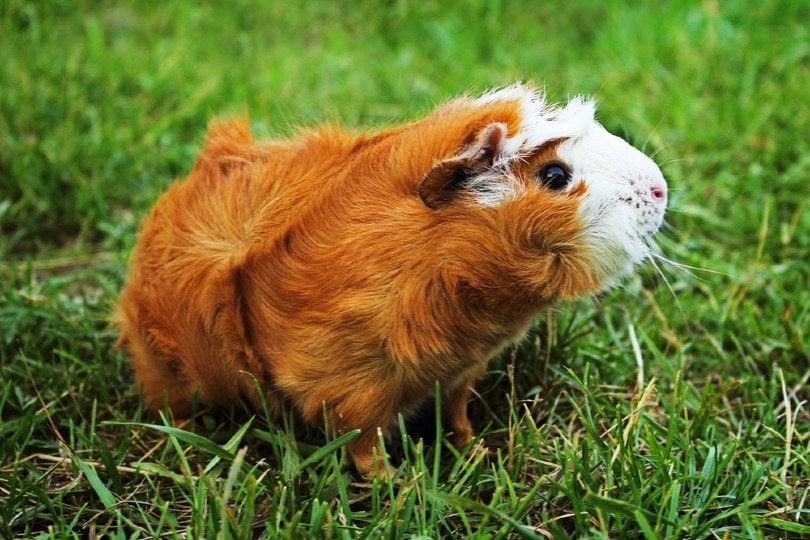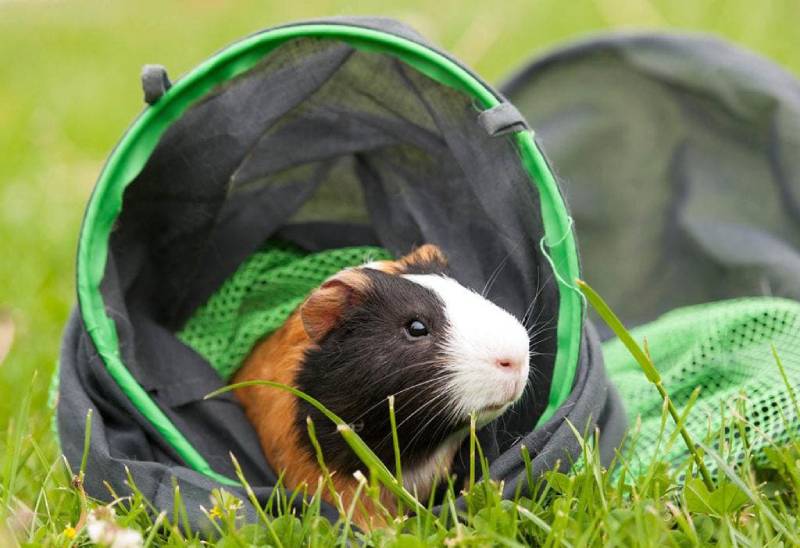Abyssinian Guinea Pig Breed: Info, Pictures, Temperament & Traits
Updated on

Click to Skip Ahead
Abyssinian guinea pigs are one of the most common and oldest breeds of guinea pigs 1. They range from every color, stemming from light beige, white, and red to black and even calico. Some research states Abyssinian guinea pigs are friendly, whereas others state they are pretty aggressive. So, the nature of the Abyssinian strictly revolves around their upbringing.
If you want to learn more about the Abyssinian guinea pig, this article explains the complete guide on what to expect when you adopt this most common breed.
Breed Overview
| Size: | 8 to 12 inches |
| Weight: | 1.5 to 4 pounds |
| Lifespan: | 5 to 8 years |
| Similar Breeds: | Abyssinian Satin |
| Suitable for: | Beginners |
| Temperament: | Vocal, friendly, and bold |
Abyssinian guinea pigs are some of the most vocal guineas and will show you their personality within the first few moments of meeting each other. They are courageous, curious, bold, and quite confident for being so small, but they love companionship.
Their big personality matches their extraordinary coat, ranging in all guinea pig colors, and with short to long fur. Interestingly, their coat has no flat spots on their bodies; eight to 10 paired rosettes extend their length.
Abyssinian Guinea Pigs Breed Characteristics
How Much Do Abyssinian Guinea Pigs Cost?
You can expect to pay between $20 to $50 for the Abyssinian guinea pig. However, if you go to a breeder, they may charge more since Abyssinians are as close to purebred guineas as it gets.
While no one knows the exact location an Abyssinian guinea pig originates from, most guinea pigs generally come from mountainous regions of South America. So, how did the Abyssinian get its name? The naming order is not clear since Abyssinians didn’t originate from Ethiopia, formerly known as Abyssinia.
However, the Abyssinian guinea pig became domesticated near 5000 BC when they coincided with the local people of the Andean region 2. Today, the Abyssinian is the most popular and most common breed of guinea pig.

Temperament & Intelligence of the Abyssinian Guinea Pigs
While all guinea pigs are primarily friendly and thrive well in groups, Abyssinian guinea pigs like to breed and stay close to their own breed. The Abyssinian is an excellent breed for beginners because they have few grooming requirements. In fact, the Abyssinian is an easy breed to train because they are curious and love to learn new things.
Abyssinians love attention and are kid friendly. However, supervision is still required, as Abyssinians can also be aggressive quickly. However, due to their bold and vocal personality, they tend to warn you if they are becoming overwhelmed or crowded.
Do Abyssinian Guinea Pigs Make Good Pets?
Abyssinian guinea pigs make excellent pets. Due to their low grooming requirements, compassionate attitude, and intelligence level, they are perfect pocket pals for the whole family. If you’re an inexperienced guinea pig owner, the Abyssinian guinea pig is the perfect guinea to learn with. They’ll grow with you and help you understand the core characteristics of all guinea pigs.
Do Abyssinians Get Along With Other Pets?
Generally speaking, guinea pigs are prey animals, so they like to hide when they feel threatened. Though with daily bonding, training, and attention, your Abyssinian can get along with anyone, including other pets.
It’s not recommended to pair guinea pigs with cats or large dogs. However, based on the temperament of your other animals, Abyssinians are laid-back and adaptable to any situation. If your animals are loving, calm, and easy-going, your Abyssinian will be too.
Things to Know When Owning an Abyssinian Guinea Pig:
Abyssinian guinea pigs are great for first-time guinea owners, though it’s best to understand the general requirements for Abyssinian guinea pigs. Learn what to expect when you adopt an Abyssinian guinea pig.
Food & Diet Requirements 🥕
Guinea pigs cannot make their own vitamin C, so providing it to their daily diet is imperative. A deficiency in vitamin C can cause scurvy, a common illness in guinea pigs.
A healthy guinea pig needs a sufficient source of vitamin C-fortified pellets, fresh fruit, and vegetables, alongside an unlimited amount of hay and fresh cold water.
Hay benefits Abyssinians because they have open-rooted teeth, which means their two front teeth never stop growing. Hay helps grind the teeth because your guinea pig must chew more to break the hay into swallowable pieces.
Guinea pigs are strictly herbivores, so avoiding meat, tiny seeds, and dairy products is best.

Habitat & Enclosure Requirements 🏡
Abyssinian guinea pigs spend their time grazing and foraging in the wild, which requires an open space. They also create caves for hiding, sleeping, and breeding. Domesticated guinea pigs need at least 7.5 square feet of space because they cannot jump easily. It’s not a good idea to have a multi-level cage.
However, it is recommended to have two or more guinea pigs. You’ll need to add at least 3 square feet of space per guinea pig if you have more than one guinea pig.
- Two guinea pigs = 10.5 square feet
- Three guinea pigs = 13.5 square feet
- Four guinea pigs = 16.5 square feet
More space allows each guinea to have its own corner, decreasing the chances of fighting while also allowing them to stay active. Abyssinians are active and curious, so ensure you provide them with plenty of toys, foraging items, and hide holes, like tunnels and caves.
It’s also a good idea to have two spaces for your Abyssinian piggy, as they like to roam free and seek different environments. Bring them outside on cooler days to allow them to explore.
Exercise & Sleeping Needs 🐹
Guinea pigs can’t bend their spine, so getting a wheel or exercise ball is never good. Instead, getting your Abyssinian piggy a playpen or a chance to roam daily is best.
Guinea pigs sleep about 6 hours daily in spurts for about half an hour. The rest of the time, they are awake and active. They forage, groom each other, sniff, play, and exercise for the remaining 18 hours. However, keeping your Abyssinian in its cage daily can cause depression and inactivity.
Due to high energy levels, allowing your guinea pig about one hour periodically throughout the day for exercise is a good idea. Guinea pigs need a total of 3 to 4 hours of free-range exercise daily.
Training
Training guinea pigs is one of the best things you can do to bond with your pocket pal. Training requires command words followed by rewards. Abyssinians can learn many tricks, including sit, stay, follow, spin, and more.
The first command you may want to train your Abyssinian is potty training, especially if you allow them to roam free in your house (under supervision). Potty training can be pretty straightforward as your Abyssinian learns and grows to bond with you.
The closer you are to your guinea pig, the easier and more adaptable your Abyssinian will be, thus leading to a well-trained and overall well-behaved pig.

Grooming ✂️
All guinea pigs need to have their nails trimmed bi-weekly as they overgrow, and it will hurt them if their nails become too long. Though some guinea pigs, like Teddys and Merinos, need weekly baths, the Abyssinian does not. In fact, bathing an Abyssinian may make their coat matted and unkept, so only bathe your Abyssinian if they are filthy.
However, brushing an Abyssinian will help speed up the bonding process and make them feel better. Because of the Abyssinian’s rosette pattern throughout their fur, they’ll need to be brushed regularly with a soft-toothed comb or even a toothbrush. Brushing your Abyssinian will reduce matting and fungal infections.
Lifespan and Health Conditions 🏥
Abyssinian has a lifespan of up to 8 years, although females may live a little shorter. However, compared to other guinea pig breeds, the Abyssinian lives up to the longest life. After all, they aren’t the most common and oldest breed for no reason.
Generally, guinea pigs’ health concerns revolve around dental, respiratory, and gastrointestinal infections. However, the Abyssinian guinea pig is generally the healthiest over other breeds. Then again, Abyssinians are prone to eye problems like cataracts and are at higher risk of developing diabetes.
It’s best not to get too concerned over your Abyssinian’s health. As long as you provide them with their dietary needs and give them optimum space with lots of time and attention, the chances of your Abyssinian becoming sick are low.
- Diarrhea
- Ear and eye disorders
- Ringworm
- Mites
- Bumblefoot
- Pulmonary neoplasia
- Pneumonia (viral and bacterial)
- Intestinal diseases
- Kidney stones
- Scurvy
Serious Conditions:
The most common serious guinea pig sickness is bacterial pneumonia. Damp or humid environments cause bacterial pneumonia. Alongside pneumonia, guinea pigs are more prone to respiratory diseases, such as pulmonary neoplasia and viral pneumonia. Although it’s unlikely your Abyssinian will come into contact with pneumonia, it’s a good idea to keep their environment clean and non-smelly.
Other serious conditions include intestinal diseases, kidney stones, and scurvy. Though with a suitable diet, chances of scurvy and intestinal illness are low. To avoid your Abyssinian guinea from contracting any illness, they should see a vet once or twice a year.
Minor Conditions:
Lesser health concerns include diarrhea, ear and eye disorders, and nutritional deficiencies. Twice a year, vet check-ups benefit your guinea pigs’ health to ensure they don’t have any minor (or major) health concerns.
If your Abyssinian’s environment is not properly kept, they can contract ringworm, mites, or bumblefoot. These minor health conditions don’t require extensive diagnosis. Though they can be life-threatening if not treated immediately.
Male vs. Female
There are no differences between male and female Abyssinian guineas (specific to their breed). However, male and female guinea pigs, in general, have differences.
Firstly, females tend to be shorter by a few centimeters and lighter by a couple of grams. It is also known that male guineas sometimes live longer than female guineas by half a year. Male guinea pigs have a dominant core characteristic, so they tend to be louder and more aggressive than females.
Overall, male and female Abyssinians are both friendly and well-tempered.
3 Little-Known Facts About the Abyssinian Guinea Pig
Aside from common knowledge of the Abyssinian guinea pig being the most common breed worldwide, you should know three more little-known facts about the Abyssinian piggy.
1. Abyssinian Is the Oldest Breed of Guinea Pigs
There are roughly 13 different breeds of guinea pigs which all evolved about 26 million years ago and are closely related to the capybara and mara. The Abyssinian is the oldest guinea pig derived from the first guinea.
2. Abyssinians Are Purebred
Since Abyssinian guinea pigs are one of the oldest guinea pig breeds, they are believed to be purebred from where they first originated.
3. Other Languages Call the Abyssinian Guinea a Rosette Guinea Pig
Other cultures classify the Abyssinian as the Rosette piggy due to the characteristics of their fur. Each Abyssinian guinea pig has eight to 10 rosettes that make up the fur pattern along its body.
Final Thoughts
Who couldn’t love the Abyssinian guinea pig, with its friendly and relaxed temperament, unique history, and distinctive fur patterns? The Abyssinian is perfect for beginner guinea pig owners and will get along with other pets and socialize with small children.
The information regarding health and safety concerns is relatively general to meet its dietary, exercise, and daily needs. When grooming your Abyssinian, you can rest easily knowing that you won’t need to bathe them daily, but they’ll enjoy a relaxing brushing regularly.
Featured Image Credit: Tettania, Shutterstock











